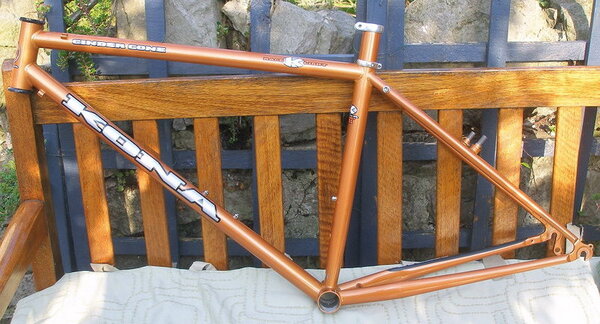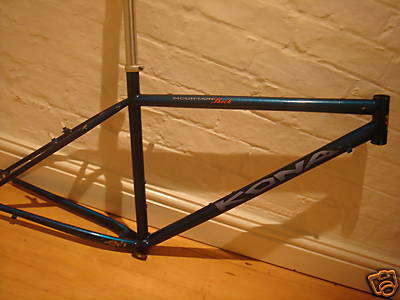There's a certain amount of information on the thread on mtbr/kona, but I guess it bears repetition, and I'll do my best to answer your new questions.
The Kona brochure for 1997 states quite baldly that the frame is "Constructed entirely of Columbus Nivacrom Max OR tubing. Tubing wall thickness: Top - .7/.4/.7, Down - .8/.5/.8. The seat tube is custom drawn for Kona by Columbus with a wall thickness of 1.3/.6/.9. Columbus drawn, oversized seat stays dramatically improve braking performance." There's nowhere for them to hide there - all that must be substantially true.
The seat tube decal visible on the 1995 frame above says "Columbus Max main frame Kona DB cromo rear stays". The seat tube decal missing from the 1996 frame is the standard Columbus Max OR decal, which also appeared on the 97 frame.
But note Top-Ring's post - "OK - here's what Kona warranty says about the rear stays... Models prior to 97 had a heavier gauge rear end. The factory stays wound up too flexy and imprecise. When we got our new dropout in 97 that let us run a bigger stay. We spec’d the full tubesets from Columbus and the Reynolds....So much for guessing. The decal reads correctly for the 95. Odd that the yellow 96 sports the authentic Columbus tubeset decal with DB stays. So only the front triangle was Columbus on the 95 and 96 models."
I actually disagree with Top-Ring (Headtube on here) about that. I think the warranty is talking just about the stays - under US consumer law, a decal has to be true of what it is attached to, so the 96 seat tube must be Columbus, and really the 95 one should be as well. And you seem to have explained that now, if the standard Max seat tube was tapered - maybe that's what they used for 95, while the 96 and 97 seat tubes were 'custom drawn' (i.e., cheaper round things, if I know Kona!)
I don't think the decision to go to a round tube for 96 can have been related to top-swing, as the bikes were sold with conventional-swing mechs. But if it related to saving money, that would make a lot more sense.
http://forums.mtbr.com/showthread.php?t=476320
The Kona brochure for 1997 states quite baldly that the frame is "Constructed entirely of Columbus Nivacrom Max OR tubing. Tubing wall thickness: Top - .7/.4/.7, Down - .8/.5/.8. The seat tube is custom drawn for Kona by Columbus with a wall thickness of 1.3/.6/.9. Columbus drawn, oversized seat stays dramatically improve braking performance." There's nowhere for them to hide there - all that must be substantially true.
The seat tube decal visible on the 1995 frame above says "Columbus Max main frame Kona DB cromo rear stays". The seat tube decal missing from the 1996 frame is the standard Columbus Max OR decal, which also appeared on the 97 frame.
But note Top-Ring's post - "OK - here's what Kona warranty says about the rear stays... Models prior to 97 had a heavier gauge rear end. The factory stays wound up too flexy and imprecise. When we got our new dropout in 97 that let us run a bigger stay. We spec’d the full tubesets from Columbus and the Reynolds....So much for guessing. The decal reads correctly for the 95. Odd that the yellow 96 sports the authentic Columbus tubeset decal with DB stays. So only the front triangle was Columbus on the 95 and 96 models."
I actually disagree with Top-Ring (Headtube on here) about that. I think the warranty is talking just about the stays - under US consumer law, a decal has to be true of what it is attached to, so the 96 seat tube must be Columbus, and really the 95 one should be as well. And you seem to have explained that now, if the standard Max seat tube was tapered - maybe that's what they used for 95, while the 96 and 97 seat tubes were 'custom drawn' (i.e., cheaper round things, if I know Kona!)
I don't think the decision to go to a round tube for 96 can have been related to top-swing, as the bikes were sold with conventional-swing mechs. But if it related to saving money, that would make a lot more sense.
http://forums.mtbr.com/showthread.php?t=476320

